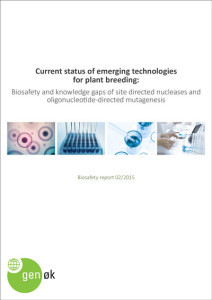New biosafety report by GenØk

The new plant breeding techniques provide the emergence of novel products that challenges our current regulations and our management practices of what we traditionally have viewed as a genetically modified organism (GMO).
International regulations, such as the Cartagena Protocol on Biosafety, operate with definitions of GMOs that may not be applicable to products arising from some of these new techniques. The question then arises on how society and regulatory bodies should view and regulate the products.
This report does not approach that problem per se, but as a crucial step in management, we sum up the current scientific understanding of two new plant breeding techniques, site directed nucleases (SDN) and oligonucleotide directed mutagenesis (ODM). The underlying mode of action of both of these techniques are the plants natural repair systems and how this can be utilized to achieve genomic modifications. Herein also lies the main challenge for risk assessment – our limited knowledge about the function of these systems, factors involved and potential off-target effects.
This report aims at providing an overview of the current status of scientific knowledge concerning SDN and ODM. We have reviewed up to date peer reviewed scientific publications on the mechanisms and natural functions that are utilized by SDN and ODM techniques in an effort to understand potential risks such as unintentional changes in the genome of plants. Finally, recommendations for action are outlined.

0 Comentarios:
Publicar un comentario
Suscribirse a Comentarios de la entrada [Atom]
<< Página Principal